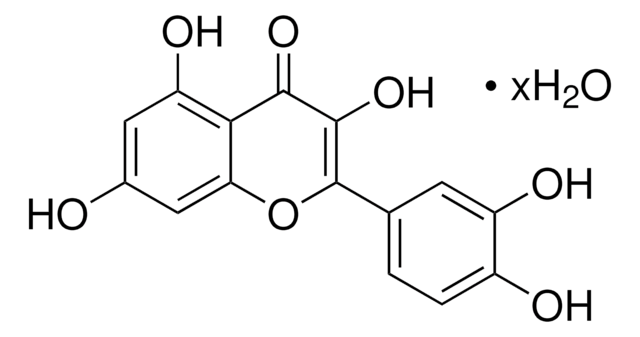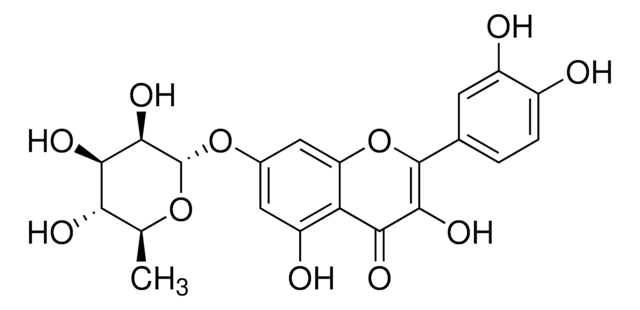PHL89270
Rutin
phyproof® Reference Substance
Synonym(s):
3,3′,4′,5,7-Pentahydroxyflavone 3-rutinoside, 3-Rutinosylquercetin, Globulariacitrin, Ilixanthi, Myrticalorin, Osyritrin, Paliuroside, Phytomelin, Quercetin 3-rhamnoglucoside, Quercetin 3-rutinoside, Rutoside, Sophorin, Tanrutin, Violaquercitrin
About This Item
Recommended Products
grade
primary reference standard
product line
phyproof® Reference Substance
Assay
≥95.0% (HPLC)
manufacturer/tradename
PhytoLab
application(s)
food and beverages
format
neat
InChI
1S/C27H30O16/c1-8-17(32)20(35)22(37)26(40-8)39-7-15-18(33)21(36)23(38)27(42-15)43-25-19(34)16-13(31)5-10(28)6-14(16)41-24(25)9-2-3-11(29)12(30)4-9/h2-6,8,15,17-18,20-23,26-33,35-38H,7H2,1H3/t8-,15+,17-,18+,20+,21-,22+,23+,26+,27-/m0/s1
InChI key
IKGXIBQEEMLURG-NVPNHPEKSA-N
Related Categories
General description
Rutin, also known as vitamin P, is an abundantly found polyphenolic flavonoid, known for its anti-inflammatory, antitumor, and anticancer properties.
Application
- Electrochemical determination of rutin using a glassy carbon electrode (GCE), modified by a copper-complexed chitosan/multiwalled carbon nanotubes (Cu-CS/MWCNT) in fruit samples of orange, lemon, lime, and apple
- Cyclic voltametric detection and quantification of rutin in pharmaceutical formulations using novel nickel nanoparticles-graphene oxide composite-glassy carbon electrode (Ni-GO/GCE)
- Spectrofluorimetric quantification of rutin in a pharmaceutical sample using carbon dots (CDs) prepared from a non-essential amino acid precursor, L-asparagine
- Analysis of human serum and pharmaceutical tablet samples for the estimation of rutin by using a porous carbon-cobalt tungstate (PC/CoWO4) nanosheet based electrochemical sensor
- Simultaneous determination of rutin and isoquercitrin by differential pulse voltammetry (DPV) using glassy carbon electrode (GCE) modified with deposition of thio-β-cyclodextrin functionalized graphene/palladium nanoparticles (SH-β-CD-Gr/PdNPs) for pharmaceutical and medical analysis
- Ionic liquid vacuum microwave-assisted extraction (ILVMAE) of rutin, hyperoside, and hesperidin from Sorbus tianschanica leaf samples for their subsequent quantification by HPLC
- Simultaneous detection and quantification of vitexin, rutin, hyperoside, and quercetin in hawthorn flower and leaf extract samples using high-performance liquid chromatography combined with spectrophotometric detection (HPLC-UV)
Other Notes
Legal Information
Storage Class Code
11 - Combustible Solids
WGK
WGK 1
Flash Point(F)
Not applicable
Flash Point(C)
Not applicable
Choose from one of the most recent versions:
Already Own This Product?
Find documentation for the products that you have recently purchased in the Document Library.
Customers Also Viewed
Our team of scientists has experience in all areas of research including Life Science, Material Science, Chemical Synthesis, Chromatography, Analytical and many others.
Contact Technical Service








